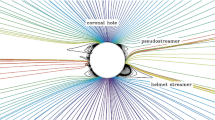Abstract
Model calculations of plasma drifts in the solar corona were performed. We established that only drifts in crossed fields could result in velocities V of several hundred kilometers per second. Such velocities are typical of coronal mass ejections (CMEs). We derived an analytic expression for V where n, the expansion harmonic of the magnetic-field strength, varies with time. As follows from this expression, V is a power function of the distance with index (2−n) and the radial component changes sign (n−1) times in the latitude range from −π/2 to +π/2. We found that if the magnetic dipole moment varies with time, the similarity between the spiral structures of coronal plasma is preserved when they displace within several solar radii and the density gradient at the conical boundaries increases (the apparent contrast is enhanced). There is a correspondence between the inferred model effects and the actually observed phenomena that accompany CMEs.
Similar content being viewed by others
References
V. I. Arnold, Mathematical Methods of Classical Mechanics (Nauka, Moscow, 1989; Springer-Verlag, New York, 1989).
D. A. Frank-Kamenetskii, A Course on Plasma Physics (Atomizdat, Moscow, 1964).
A. J. Hundhausen, J. Geophys. Res. 98, 13177 (1993).
S. A. Koutchmy, private communication.
S. A. Koutchmy, V. L. Merzlyakov, and M. M. Molodensky, Astron. Zh. 78, 953 (2001) [Astron. Rep. 45, 834 (2001)].
J. Linker and Z. Mikić, Astrophys. J. 438, L45 (1995).
M. M. Molodensky and B. P. Filippov, Magnetic Fields of Solar Active Regions (Nauka, Moscow, 1992).
M. M. Molodensky, B. P. Filippov, and N. S. Shilova, Astron. Zh. 69, 181 (1992) [Sov. Astron. 36, 92 (1992 )].
P. M. Morse and H. Feshbach, Methods of Theoretical Physics (McGraw-Hill, New York, 1953; Inostrannaya Literatura, Moscow, 1960), Vol. 2.
O. C. St. Cyr, J. T. Burkepile, A. J. Hundhausen, and A. R. Lecinski, J. Geophys. Res. 104, 12493 (1999).
Author information
Authors and Affiliations
Additional information
__________
Translated from Pis’ma v Astronomicheski\(\overset{\lower0.5em\hbox{$\smash{\scriptscriptstyle\smile}$}}{l}\) Zhurnal, Vol. 28, No. 4, 2002, pp. 314–320.
Original Russian Text Copyright © 2002 by Molodensky, Merzlyakov.
Rights and permissions
About this article
Cite this article
Molodensky, M.M., Merzlyakov, V.L. Plasma drift in the solar corona. Astron. Lett. 28, 272–278 (2002). https://doi.org/10.1134/1.1467263
Received:
Issue Date:
DOI: https://doi.org/10.1134/1.1467263




